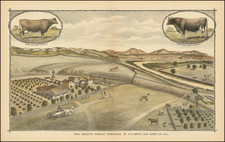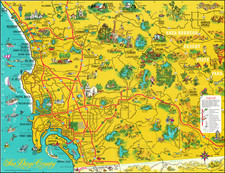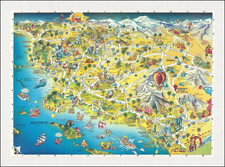The Waterfront Route of the California Southern Through San Diego
Finely executed pair of hand drawn maps of the route of the California Southern Railroad from the area below Mission Hills to National City, drawn on drafting linen sheets (10 feet each) by Joseph Osgood.
The map focuses on the course of the railroad line (in red), with the contiguous streets meticulously added. The coastline of San Diego Bay is shown in blue, noting the different neighborhoods along the way, including:
- Middletown
- New Town
- Horton's Addition
- Cleveland's Addition
- Mannasse & Schiller's Addition
- National City
In addition to the early towns, the owners of large undeveloped tracts are noted, including the lands of the Texas & Pacific Railway Co. (in anticipation of the arrival of a transcontinental link to the east) and a number of individual owners.
The pencil note shows that the present map was used in connection with litigation in San Diego County Superior Court, California Southern Rail Road Company v. Frank A. Kimball et al. In 1873 Kimball, Alonzo Horton and other major San Diego landowners urged Colonel Thomas Scott, President of the Texas & Pacific railroad, to use San Diego as its western terminus. For the next eight years the attempt to gain an entrance into the growing national rail link encompassed much of the energy of the controlling members of San Diego society. Previously, in 1871, the Texas & Pacific was chartered by Congress to build from Marshall, Texas along the 32nd parallel to the Colorado River and then on to San Diego. Kimball offered one-half of his ranch, a new wharf, and 200 acres of bay land, if the terminal of the railroad were located in National City. The residents of San Diego added an additional 9,000 acres to convince Scott to build to the Bay area.
As noted by Lowell,
The panic and consequent depression of 1873 resulted in a severe shortage of funds for the Texas & Pacific. Colonel Scott went to Congress to get the government to guarantee interest on his company’s bonds. At the same time, the Central Pacific convinced Congress to allow the Southern Pacific (it was not until 1880 that the different railroad holdings of the Big Four—Leland Stanford, Colis P. Huntington, Charles Crocker and Mark Hopkins—were consolidated under the name of the Southern Pacific Railroad) to connect with Scott’s line at the Colorado River. Jay Gould, who at this time controlled the Union Pacific, was Scott’s ally. The Big Four feared that if the Texas & Pacific were allowed to reach the coast it would damage the monopoly of west coast lines by the Central Pacific. The Big Four hoped to beat Scott to Arizona, build through that state and then convince the government to give them the land grants and right of way of the Texas and Pacific. They realized that Scott would never be able to get government funding for a duplicate road. The Big Four were half right. Congress revoked the Texas & Pacific charter, but kept the lands. However, the Southern Pacific had completed a line from San Francisco via Los Angeles, Yuma, Tucson, El Paso through to New Orleans and the Gulf of Mexico. Scott had been beaten and San Diego was again left without a rail link to the interior. Stockton, San Bernardino, Visalia and Bakersfield, like San Diego, all failed to make sufficient grants of land and money to the Southern Pacific, and were also bypassed.
California Southern Railroad / Connecting San Diego By Rail
Beginning shortly after arrival of Alonzo Horton in 1867, San Diego's prominent citizens worked to persuade the railroads to connect to San Diego. In 1868, the San Diego & Gila Railway was planned, with the intent of connecting San Diego and Fort Yuma, a venture which failed to gain a land grant and ended in bankruptcy. Frank Kimball, founder of National City, attempted to persuade Charles Crocker to bring the Central Pacific to San Diego, an effort which failed when Kimball refused to sell six miles of prime bayfront real estate to the Central Pacific. Crocker responded that Kimball would never live to see a railroad built to San Diego. Never would a competitor of the Central Pacific be allowed to interfere.
The first significant progress was in 1873, when Horton and Kimball made a pitch to Colonel Thomas Scott, president of the Texas & Pacific Railroad, to use San Diego for its western terminus While initially encouraging, the effort failed when the Southern Pacific completed its line to San Francisco via Los Angeles, Yuma, El Paso and New Orleans.
As noted by Lowell,
San Diego business leaders realized that they would have to gain a powerful ally to counter the tremendous power of the Central Pacific. Frank Kimball . . . [also] approached Jay Gould to help San Diego obtain a railroad. . . . Gould replied to Kimball’s inquiry: “I don’t build railroads: I buy them."
Undaunted, Kimball went to Boston to negotiate with the Directors of the [Atchison Topeka &] Santa Fe in 1879. They agreed, after sufficient promise of money and land, to make San Diego the western terminus of their line. Thomas Nickerson, President of the Santa Fe, promised to send representatives to San Diego to look over the proposed roadway. Kimball wrote to Nickerson, “For God’s sake send men who can’t be bought by Stanford."
* * *
Late in 1879 the Santa Fe railroad purchased a one-half interest in the St. Louis and San Francisco Railroad, and thereby became owners of the Atlantic and Pacific Company. This purchase gave the Santa Fe access to the Atlantic & Pacific land grant in California. The Santa Fe changed its expansion plans and decided to build to Needles. . . Kimball returned to Boston and renewed his offer to ensure the completion of the earlier planned route to San Diego. Kimball promised to give the railroad 10,000 acres of land, create a Land Company in San Diego to manage the railroad land sales, and offered an additional 6,000 acres to start that company. An agreement was reached that the Boston directors would form a new company to build from the bay of San Diego to a connection with the Atlantic & Pacific road. On October 12, 1880 the California Southern Railroad was chartered. The Directors of the Santa Fe also sat on the Board of California Southern. Thomas Nickerson was president of both lines. Frank Kimball sat on the Board of Directors for the California Southern.
Kimball's efforts were successful in part. As noted by Dodge,
Kimball returned buoyant with hopes. Representatives George B. Wilbur, Lucius G. Pratt and Chief Engineer William R. Morley, the latter of "Royal Gorge [Railroad War]" fame, were sent out from Boston. Morley reported that there were no serious physical obstacles in the way between San Diego and Yuma, so surveys were started for a line directly east from San Diego, only to be stopped by orders from Boston . . .
As a result of the planning, local investors and the San Fe formed the California Southern Railroad and by the end of 1880, over $3,000,000 had been raised to build a railroad to San Diego and National City. Work commenced in 1881, via a planned route from National City to Oceanside, then through Temecula Canyon north to Colton, near San Bernardino. The first locomotive for the new line was shipped east from Boston, arriving in National City on July 13, 1881, with the line through to Colton completed on August 14, 1882.
The line operated from November 1882 to March 1884, with telegraph lines run and offices in National City, San Diego and Fallbrook. Unfortunately, the massive rainstorms of 1884 resulted in tremendous damage to bridges and the road bed, forcing the line to close on March 19, 1884.
It would take until November 1885 and significant restructuring of debt and re-alignment of national railroad interests, before the line would be completed through to San Bernardino, ushering in the first real economic boom in San Diego. By 1890, the population grew from 2,800 to 16,000, with unofficial estimates suggesting the real population peaked at closer to 30,000.
Rarity
The map is unrecorded.













![Partition of Rancho Mission of San Diego San Diego, California -- Made under Decree of Superior Court dated January 7th, 1885, By Chas. J. Fox, C.E, O.H. Borden, M.C. Woodson ] Referees. Filed January 14th 1886. J.M. Dodge, Clerk.](https://storage.googleapis.com/raremaps/img/small/101388.jpg)

![[ Before The Salton Sea ] [ Official Map of San Diego County compiled from latest official maps of U.S. surveys, railroad and irrigation surveys, county records, and other reliable sources . . . Northeast Sheet ]](https://storage.googleapis.com/raremaps/img/small/101378.jpg)
![[ Southern California Tourism ] Hunting and Fishing in Southern California on the Santa Fe](https://storage.googleapis.com/raremaps/img/small/101613.jpg)